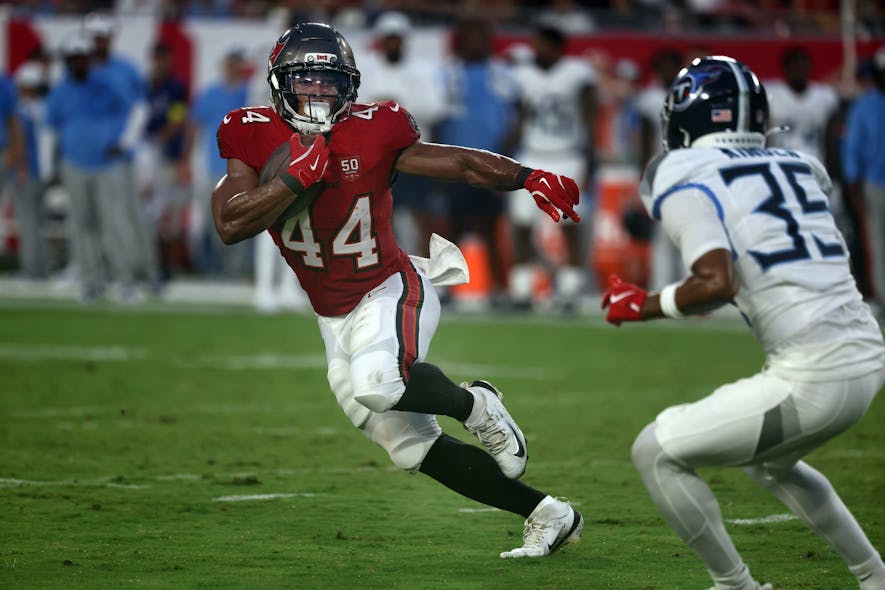Why Late-Round Running Backs Decide Your League (And How to Find Them)
We all want to hit on our late-round picks, but running backs are different. Unlike late-round tight ends, who even in a perfect scenario usually only help you keep pace with the competition, late-round running backs can decide the outcome of your league.
In 2024, Chase Brown, Chuba Hubbard, Rico Dowdle, Bucky Irving, and J.K. Dobbins were all drafted after pick 100. Every one of them finished inside the top 24 running backs in fantasy points per game. The year before, Kyren Williams went mostly undrafted and ended as the RB7, while Raheem Mostert had an ADP in the 140s and produced a top-five season.
The end-of-year ranks tell part of the story, but the real value was in their hot streaks. These guys all had weeks that carried you through byes, covered for injuries, salvaged early-round busts, and sometimes just gave you a massive weekly edge over your league mates. Starter-level production from your last few bench spots wins championships, and no position delivers it more often than running back.
Why Pure Handcuffs Rarely Pay Off
There is always some luck involved in picking the right late-round backs, but there is also a process. Pure handcuffs who only play if the starter gets hurt rarely pay off, because you will probably be forced to cut them before an injury to the starter occurs.
The better approach is to hunt for fluid depth charts on good offenses—backfields where the starter's role is not set in stone and the cheaper option already has a path to meaningful touches. In these situations, talent, opportunity, and offensive surroundings can converge quickly, turning a late-round flier into a difference-maker.
This Year's Top Late-Round Running Back Candidates
Tank Bigsby, Jacksonville (ADP 117)
Drafting Bigsby with confidence takes more conviction after Travis Etienne Jr. opened Jacksonville's first preseason game as the clear starter. Etienne played all 11 snaps on the first drive, while Bigsby worked with the backups into the second quarter. This development followed offensive coordinator Grant Udinski praising Etienne earlier in the week.
Before Etienne drew the start, our Jacksonville Preseason Update noted that "most camp observers believe Bigsby is being treated as the lead back." Bigsby has also received praise from the coaching staff since camp opened, so how much stock to put into the Jaguars' coachspeak is up for debate.
Adjusting to new information in August is important, but it is too early to call this battle in Etienne's favor, especially when Bigsby was the far better runner in 2024 (data per PFF):
| Statistic | Etienne | Bigsby |
|---|---|---|
| Missed tackle % | 11.3% (30/31) | 27.4% (4/31) |
| 15+ yard run % | 19% (25/31) | 31.6% (8/31) |
| Yards after contact/attempt | 2.48 (30/31) | 3.74 (2/31) |
Regardless of who gets the "starter" label, the most likely setup is a rotation on base-downs, with Etienne handling obvious passing plays and Bigsby getting the short-yardage work, including goal-line carries. This role would make Bigsby a what-the-heck flex option with multiple paths to upside:
- Jacksonville's offense clicks under Liam Coen, giving Bigsby more goal-line and early-down work than expected.
- Bigsby continues to show his elusiveness and burst while Etienne keeps going down on first contact, leading to a larger share of carries.
- An Etienne injury hands Bigsby the majority of the rushing workload.
- While a long shot, we can't rule out Etienne getting traded. He's in the last year of his contract with no ties to the new coaching regime, whose first move was to draft two potential replacements.
Etienne (ADP 98) is going well ahead of Bigsby, while Bhayshul Tuten (ADP 148), a Day 3 rookie without a clear role, is still drafted before him in some leagues. While we also have to remain open to Tuten closing the gap before camp is over, Bigsby is the best runner in this backfield and also the best value.

